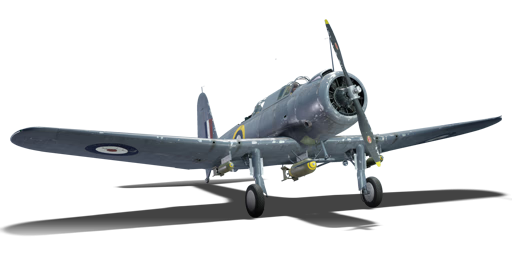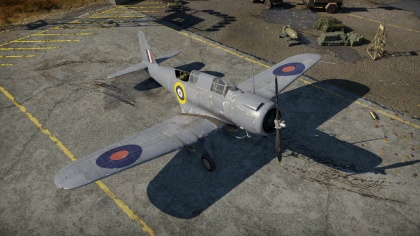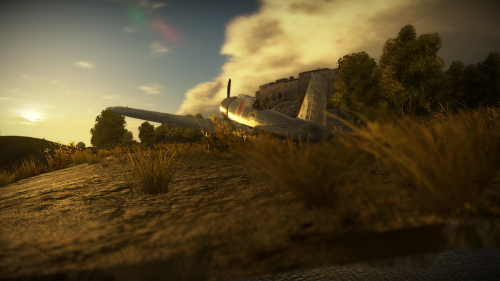V-156-B1
Contents
| This page is about the British bomber V-156-B1. For the French version, see V-156-F. |
Description
The V-156-B1 is a rank I British bomber
with a battle rating of 1.3 (AB/SB) and 1.0 (RB). This aircraft was introduced in Update 1.75 "La Résistance".
General info
Flight Performance
Describe how the aircraft behaves in the air. Speed, manoeuvrability, acceleration and allowable loads - these are the most important characteristics of the vehicle.
| Characteristics | |||||||
|---|---|---|---|---|---|---|---|
| Stock | |||||||
| Max Speed (km/h at 4,084 m) |
Max altitude (meters) |
Turn time (seconds) |
Rate of climb (meters/second) |
Take-off run (meters) | |||
| AB | RB | AB | RB | AB | RB | ||
| 343 | 328 | 6800 | 23.2 | 24.5 | 4.5 | 4.5 | 300 |
| Upgraded | |||||||
| Max Speed (km/h at 4,084 m) |
Max altitude (meters) |
Turn time (seconds) |
Rate of climb (meters/second) |
Take-off run (meters) | |||
| AB | RB | AB | RB | AB | RB | ||
| 380 | 360 | 6800 | 20.9 | 22.0 | 8.2 | 6.2 | 300 |
Details
| Features | ||||
|---|---|---|---|---|
| Combat flaps | Take-off flaps | Landing flaps | Air brakes | Arrestor gear |
| X | X | ✓ | ✓ | ✓ |
| Limits | ||||
|---|---|---|---|---|
| Wing-break speed (km/h) |
Gear limit (km/h) |
Combat flaps (km/h) |
Max Static G | |
| + | - | |||
| 740 | ~14 | ~8 | ||
| Optimal velocities | |||
|---|---|---|---|
| Ailerons (km/h) |
Rudder (km/h) |
Elevators (km/h) |
Radiator (km/h) |
| < 300 | < 350 | < 320 | > 299 |
| Compressor (RB/SB) | ||
|---|---|---|
| Setting 1 | ||
| Optimal altitude | 100% Engine power | WEP Engine power |
| 2,895 m | 750 hp | 825 hp |
Survivability and armour
- 9.5 mm Steel plate between cockpit and turret.
- 3 mm Steel boxes behind the gunner.
Armaments
Offensive armament
The V-156-B1 is armed with:
- 4 x 7.7 mm Browning .303 machine guns, wing-mounted (1,000 rpg = 4,000 total)
Suspended armament
The V-156-B1 can be outfitted with the following ordnance:
- 1 x 500 lb AN-M64A1 bomb + 2 x 100 lb AN-M30A1 bombs (700 lb total)
- 1 x 500 lb AN-M64A1 bomb + 2 x 250 lb AN-M57 bombs (1,000 lb total)
- 1 x 1,000 lb AN-M65A1 bomb (1,000 lb total)
Defensive armament
The V-156-B1 is defended by:
- 1 x 7.7 mm Browning .303 machine gun, dorsal turret (600 rpg)
Usage in battles
The V-156-B1 is easily one of the more powerful aircraft in the lower battle ratings and can be an absolute monster at low battle rated arcade matches due to its monoplane design, payload, and a large number of offensive machine guns. It is adequate for grinding at low ranks due to its low repair cost and versatility. It can gladly function as both a fighter and an attacker, and once dumping bombs, is capable of Boom & Zooming enemies in the vicinity. In addition, it has airbrakes in the form of dive brakes, which come in useful when landing, attacking ground targets or attempting to shake off an enemy. Although you have a turret, you should not rely on it to be able to destroy fighters on its own - it is good at fending off fighters and keeping newer and/or more cautious players at bay, but it will only be able to shoot down fighters on its own by sheer luck. Your frontal armament, however, is more powerful - and with the usage of airbrakes at critical moments in the fight, such as when the enemy is close to you and approaching from the rear, you can use your airbrakes while reducing your throttle to zero to induce what is known as an 'overshoot'- forcing the enemy behind you to zoom over you instead of staying on your tail by means of a sudden speed decrease. This puts the enemy in front of you and allows you to use your four frontal machine guns to shoot down the lightly-armoured enemies you face at this battle rating.
Arcade Ground Strike maps - where the aim is to destroy the enemy's ground troops, and often, dogfights happen over ground targets at low altitudes - are where this aircraft will excel most. A suggested strategy is to use the aircraft as a dive-bomber in arcade battles, using your superior altitude and therefore speed advantages (you start in the bomber spawn) to hit ground targets before zooming back towards friendlies, or waiting until the fighters have started engaging, and then attack ground targets. The aircraft (at stock payload) has two 100 lb bombs and one 500 lb bomb. At these low BRs, your bombs will annihilate enemy armoured car and AAA formations, and your guns are nigh-upon-unstoppable at this BR. Use "Universal" or "Tracer" belts for best effect.
While waiting for payload reload, go for enemy planes. British, German and Japanese aircraft are particularly vulnerable to your attacks due to their relatively low armament in a head-on engagement and lack of any and all armour protection. Soviet biplanes (the I-15s) will have heavier or equal armament, and American monoplanes will be harder to kill than biplanes due to robust construction and having similar speeds. At a BR of 1.3, the best opposition you will face are P-40s, Bf-109E-1s, Ki-43s and H-75s. All of these aircraft have large amounts of machine guns with exhaustive ammo pools, and if they can catch up to you, you're likely going to be shot down by the opposition, since you don't have the performance to fight them without assistance. If you feel lucky, you can duke it out by baiting them into a turn fight, where your good turn radius with landing flaps active can make you the victor in the situation. Never rely upon your single rear gun to keep you safe- at best it can only really function as a deterrent to keep fighters at bay. Always keep an eye on your six, and when you finish a ground attack run, look around and see if anything's coming before you go in again. If you see a fighter coming for you and can manage to turn towards them enough that you can get a firing solution on them, you can probably win. British 7.7mm guns are among the best in the game in terms of raw fire chance values and penetration, and if loaded with the "Tracer" belt- a full mix of Incendiary Tracer (essentially a standard incendiary bullet with a tracer element) and Armour-Piercing Incendiary (Usually the most damaging type of bullet in any given gun) in 50% proportion to each other- they can shred through any air target at a battle rating of 1.3.
A suggested loadout is a minimum load of fuel (33 minutes, more than enough for arcade battles or realistic battles), Universal or Tracer 7 mm belts on both defensive and offensive 7 mm guns (maximal AP-I ammunition) and the payload of 2 x 250 lb bombs and 1 x 500 lb bomb.
Manual Engine Control
| MEC elements | ||||||
|---|---|---|---|---|---|---|
| Mixer | Pitch | Radiator | Supercharger | Turbocharger | ||
| Oil | Water | Type | ||||
| Controllable | Controllable Not auto controlled |
Controllable Not auto controlled |
Controllable Not auto controlled |
Separate | Not controllable 1 gear |
Not controllable |
Modules
| Tier | Flight performance | Survivability | Weaponry | ||
|---|---|---|---|---|---|
| I | Fuselage repair | Radiator | Offensive 7 mm | FSBC mk.5 | |
| II | Compressor | Airframe | New 7 mm MGs | ||
| III | Wings repair | Engine | Turret 7 mm | FLBC mk.1 | |
| IV | Engine injection | Cover | New 7 mm MGs (turret) | ||
Weaponry upgrades and engine should be prioritized with this aircraft, due to its role as an attacker. Its two primary roles are lugging bombs where they need to be in the minimal amount of time possible and then using them to inflict maximum damage. The FSBC mk.5 gives quite an upgrade to the aircraft, replacing the 100 lb bombs (mediocre at best) with the more powerful 250 lb bombs. However, the FLBC mk 1 is a novelty, at best, and only really useful when lugging bombs onto bases in Operation mode in RB. However, the V-156-B1 is a very bad choice for such a role, and thus, it should be disregarded.
A good research pathway is FSBC mk.5 --> Offensive 7mm Belts --> New 7mm MGs --> Defensive 7mm Belts --> Engine --> New 7mm MGs (Turret) --> Engine Injection. Anything after that is fair game. However, the FLBC mk.1 should be left until last, due to its uselessness in battles.
Pros and cons
Pros:
- Gives the low-rank British player a much-needed replacement for the Swordfish
- It's faster than the Swordfish, and carries more powerful bombs too
- Rear gun has double the amount of ammunition, and the aircraft has a better forward-facing armament
- Good payload- The 500 lbs and 250 lbs bombs are more than enough to penetrate and destroy enemy tanks
- Four offensive machine guns can destroy unarmoured ground targets and other aircraft
- Above average speed against its usual enemies- reserves and low-rank aircraft
- Defensive machine gun keeps enemy fighters at bay
Cons:
- Not particularly fast - Easy prey for low-rank monoplanes and even some bi-planes
- Dead meat if up-tiered or used actively as a fighter - It simply does not have the performance nor the firepower to out-match fighters
- Poor elevator response, especially at high speeds; this means diving attacks from a high altitude (e.g. in RB) are hard to pull off and will require some planning in order to avoid ripping your wings off and/or compressing
- The craft only has landing flaps, that cannot be activated when airbrakes are on, and vice-versa
- Low cockpit visibility due to the "birdcage" construction and the fact that the rear cockpit view is quite limited due to the limited traverse of the rear gun
- Stock payload has the weak 100 lbs bombs which have a low armour kill radius (2 metres) and require some skill to get on target without missing or not penetrating
- Single .303 inch defensive machine gun is better than nothing, but only really serves as a deterrent as the plane will probably be dead by the time the gunner has the chance to knock out the enemy hostile since you only have the one gun
- Not very manoeuvrable, especially with payloads equipped
History
The Vought V-156-B1 was originally an American plane. It was designed and built to meet a United States Navy order for a new Scout bomber for carrier use. It had the United States Navy designation of the SB2U and was given the nickname the "Vindicator". Few orders for this aircraft was given by the United States Navy due to the equally good if not superior SBD Dauntless dive bomber. It ended up in the hands of the Fleet Air Arm after the defeat of France. The French ordered 50 of these planes before their collapse. The FAA used them on various escort carriers and called the plane the "Chesapeake". The Chesapeake was phased out in November 1941 and was replaced by the faithful and reliable Fairey Swordfish.
Media
Excellent additions to the article would be video guides, screenshots from the game, and photos.
See also
Other planes in the V-156 Family:
Equivalents in other nations' trees:
External links
Paste links to sources and external resources, such as:
- topic on the official game forum;
- encyclopedia page on the aircraft;
- other literature.
| Chance Vought Aircraft | |
|---|---|
| Fighters | |
| Corsair | F4U-1A · F4U-1A (USMC) · F4U-1C · F4U-1D · F4U-4 · F4U-4B · F4U-4B VMF-214 |
| Float planes | OS2U-1 · OS2U-3 |
| Attackers | AU-1 |
| Bombers | SB2U-2 · SB2U-3 |
| Jet aircraft | |
| Corsair II | A-7D · A-7E · A-7K |
| Crusader | F8U-2 · F-8E |
| Export | V-156-B1 · V-156-F · ▄Corsair F Mk II · F4U-7 · ▄F-8E(FN) |
| Captured | ▅F4U-1A |
| Britain bombers | |
|---|---|
| Torpedo | Swordfish Mk I · Swordfish Mk II · ▄Avenger Mk II |
| Dive | V-156-B1 |
| Hydroplanes | ▄Catalina Mk IIIa · Sunderland Mk IIIa · Sunderland Mk V |
| Light | Blenheim Mk IV · Beaufort Mk VIII · ▄Hudson Mk V · Brigand B 1 |
| Based on A20 | ▄Havoc Mk I · ▄Boston Mk I · ▄DB-7 |
| Hampden | Hampden Mk I · Hampden TB Mk I |
| Wellington | Wellington Mk Ic · Wellington Mk Ic/L · Wellington Mk III · Wellington Mk X |
| Halifax | Halifax B Mk IIIa |
| Stirling | Stirling B Mk I · Stirling B Mk III |
| Lancaster | Lancaster B Mk I · Lancaster B Mk III |
| Lincoln | Lincoln B Mk II |
| Shackleton | Shackleton MR.Mk.2 |






